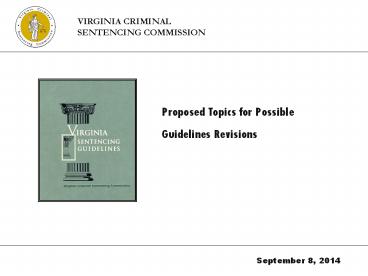Proposed Topics for Possible Guidelines Revisions - PowerPoint PPT Presentation
Title:
Proposed Topics for Possible Guidelines Revisions
Description:
Title: PowerPoint Presentation Author: VCSC Last modified by: Meredith Farrar-Owens Created Date: 6/1/2001 4:13:43 PM Document presentation format – PowerPoint PPT presentation
Number of Views:158
Avg rating:3.0/5.0
Title: Proposed Topics for Possible Guidelines Revisions
1
Proposed Topics for Possible Guidelines
Revisions
VIRGINIA CRIMINAL SENTENCING COMMISSION
- September 8, 2014
2
Proposals for New Guidelines Offenses
- Proposals reflect the best fit for the historical
data. - Proposals are designed to closely match the
historical rate of incarceration in prison and
jail. - Current guidelines worksheets serve as the base
for scoring historical cases, but the points
assigned to those factors may be different for
the new offense and new factors may be added.
3
Suggestions for New Guidelines Offenses
- Distribution of Schedule IV drugs (
18.2-248(E2)) - Strangulation resulting in injury or bodily
wounding ( 18.2-51.6) - Obtaining identifying information with intent
to defraud, 2nd or subsequent
conviction (
18.2-186.3(D)) - Receiving, buying, or selling stolen credit card
or credit card number ( 18.2-192 (1,b), (1,c),
and (1,d))
4
Distribution of Schedule IV Drugs ( 18.2-248(E2))
- The penalty for distribution of a Schedule IV
drug was increased from a Class 1 misdemeanor to
a Class 6 felony in 2005. - Generally, Schedule IV drugs have less potential
for abuse and dependency compared to Schedule III
drugs. Many of these drugs are accepted in
medical treatment (e.g., managing seizures,
anxiety, and insomnia).
5
Distribution of Schedule IV Drugs ( 18.2-248(E2))
- Many Schedule IV drugs have a depressant effect
on the central nervous system. - Schedule IV drugs include Valium, Xanax,
Darvocet, Ativan, and other tranquilizers and
sedatives.
6
Distribution of Schedule IV Drugs ( 18.2-248(E2))
- According to a recent study, the use of
benzo-diazepines (Schedule IV drugs) is
especially problematic in PTSD patients who also
have substance-abuse disorders or mild traumatic
brain injuries. The Department of Defense and the
Veterans Administration guidelines especially
caution their use with patients suffering from
combat-related PTSD because more than half of
such patients abuse alcohol or drugs.
Source Stars and Stripes
http//www.stripes.com/news/sedatives-still-used-f
or-ptsd-treatment-despite-warnings-1.215000
(accessed September 4, 2014)
7
Distribution of Schedule IV Drugs (
18.2-248(E2))FY2012 FY201352 Cases
Disposition Percent Median Sentence
No Incarceration 38.5 NA
Incarceration Up to 6 Months 50.0 1.8 Months
Incarceration More than 6 Months 11.5 1.1 Years
Note Data reflect cases in which this offense
was the primary (or most serious)
offense at sentencing. Source Supreme Court of
Virginia, Circuit Court Case Management System
(CMS)
8
Strangulation ( 18.2-51.6)
- Any person who, without consent, impedes the
blood circulation or respiration of another
person by knowingly, intentionally, and
unlawfully applying pressure to the neck of such
person resulting in the wounding or bodily injury
of such person is guilty of strangulation, a
Class 6 felony.
(Effective July 1, 2012)
9
Strangulation ( 18.2-51.6)
- Strangulation under 18.2-51.6 is not currently
covered by the guidelines. - In some cases, users have incorrectly prepared
the guidelines using the Class 6 felony of
unlawful wounding. - Staff have received numerous requests to add this
offense to the guidelines.
10
Style Weekly July 9, 2013
11
Obtaining identifying information with intent to
defraud, 2nd or subsequent conviction (
18.2-186.3(D))
- Section 18.2-186.3, defining identity fraud
offenses, was added to the Code of Virginia in
2000. - One of the five felony offenses in this Code
section is currently covered by the guidelines. - Added in 2006
12
Identity Fraud ( 18.2-186)
Obtain identifying info. with intent to defraud 18.2-186.3(A) Class 1 misd.
Sell or distribute, obtain identifying info. with intent to defraud 18.2-186.3(B) Class 1 misd.
Obtain identifying info. to avoid arrest or impede investigation 18.2-186.3(B1) Class 1 misd.
Obtain identifying info. of 5 or more people 18.2-186.3(D) Class 5 felony
Obtain identifying info. of 50 or more people 18.2-186.3(D) Class 4 felony
Obtain identifying info. with intent to defraud, 2nd or subsequent 18.2-186.3(D) Class 6 felony
Use of identifying info. to defraud, results in detention of victim 18.2-186.3(D) Class 5 felony
Use of identifying info. to defraud, financial loss greater than 200 18.2-186.3(D) Class 6 felony
Covered by current guidelines
13
Receiving, buying, or selling stolen credit card
or credit card number ( 18.2-192 (1,b), (1,c),
and (1,d))
- Section 18.2-192 was last modified in 1985.
- One of the four felony offenses in this Code
section is currently covered by the guidelines. - Covered by truth-in-sentencing guidelines when
implemented in 1995
14
Credit Card Offenses ( 18.2-192 and 18.2-194)
Covered by current guidelines
Theft of credit card or credit card number 18.2-192(1,a) Felony 1 - 20 years
Receive stolen credit card or credit card number with intent to use or sell 18.2-192(1,b) Felony 1 - 20 years
Sell or buy stolen credit card or credit card number 18.2-192(1,c) Felony 1 - 20 years
Receive 2 or more stolen credit cards within 12 months 18.2-192(1,d) Felony 1 - 20 years
Possession of two or more signed credit cards 18.2-194 Felony 1 - 20 years
This offense could also be included in the
analysis
15
Proposals for Revisions to Existing Guidelines
Offenses
- Proposals are designed to maximize compliance and
balance mitigation and aggravation rates to the
extent possible. - Current guidelines worksheets serve as the base
for scoring historical cases, but the points
assigned to those factors may be adjusted and new
factors may be added.
16
Burglary Offenses ( 18.2-89, 18.2-91, and
18.2-92)
- Examine importance of
- Time of day of the offense
- Whether a person was present in the structure at
the time of the offense - Victim injury
- This analysis would require a special study, as
additional case details would need to be
collected.
17
(No Transcript)
18
Proposed Topics for Possible Guidelines Revisions
- Approval to proceed with proposed analyses
- Suggestions from Commission members for other
topics































